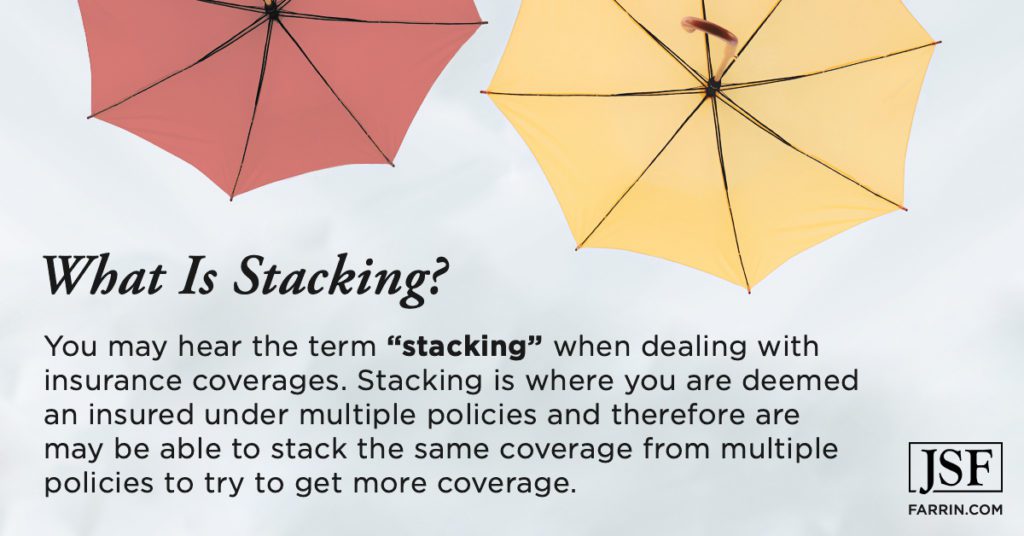Most people don’t think much about their auto insurance until they need it. There’s a reason that personal injury attorneys exist. Sometimes, even with all the insurance, you have to file a personal injury lawsuit in order to receive fair compensation. Where does that compensation come from?
If you’re injured in an accident in North Carolina, there are generally four (4) types of automobile insurance coverages that may come into play. These four coverages are liability coverage, uninsured motorist coverage (UM), underinsured motorist coverage (UIM) and medical payments coverage. Both liability coverage and uninsured motorist coverage are mandatory coverages for all drivers under the North Carolina Motor Vehicle Safety and Financial Responsibility Act. The others are optional.
What Is Liability Insurance and What Does It Do?
Liability Insurance covers your liability, or fault, in an automobile wreck as it relates to other parties’ bodily injury or property damage. Conversely, if you are the victim of a negligent driver, then their liability coverage covers any damages you may have which may include, but are not limited to medical bills, lost wages, pain, and suffering, as well as damage to your automobile.
In North Carolina, the law requires that the owner of a registered and operated motor vehicle must carry the following minimum amounts of insurance coverage: a minimum of $30,000 for bodily injury per person, $60,000 bodily injury per accident and $25,000 property damage.
In certain situations, when the injuries are serious, an injured party can collect liability coverage from multiple policies. The most common way this occurs is when the at-fault driver is driving someone else’s vehicle yet owns an insured vehicle himself. Under this scenario, the injured party can collect from the liability policy covering the at-fault vehicle actually involved in the wreck, and also from the liability policy of the at-fault driver’s own vehicle that was not involved assuming the total damages exceeded the coverage of the at-fault vehicle.
If We All Have Uninsured Motorist Coverage, There Are No Uninsured Motorists, Right?
Not quite. Uninsured Motorist Coverage (UM), as defined by North Carolina’s Department of Insurance, is coverage that “will provide protection when an uninsured driver, who is at-fault, injures you or another covered individual.” It also provides property damage coverage.
Sadly, not all vehicles are insured. An uninsured vehicle may be a vehicle where the owner has failed to carry insurance on the vehicle in violation of State law. It can also be a stolen vehicle being driven by the perpetrator or any other person without expressed or implied consent by the owner to be operating the vehicle. An uninsured vehicle can also be a vehicle whereby the owner has purchased the requisite insurance policy, but for one of various reasons the insurance company has denied coverage for a particular loss.
An example of such a situation would be if there were a material misrepresentation made on an insurance application that the insurance company later finds out about, like the applicant representing the car being used by an accident-free 50 year old to go to and from work when the vehicle is really being used by his 16 year old son. That may cause the insurance carrier to deny coverage for a particular loss.
Finally, uninsured coverage may be necessary if you are the victim of a hit and run are not able to ascertain the identity of the perpetrator or whether the at-fault vehicle is insured. Please note, however, because of North Carolina’s “No Contact Rule” for uninsured accident claims, if the hit-and-run vehicle (phantom vehicle) does not make contact with your vehicle, uninsured motorist coverage will not apply. An example of this may be a phantom vehicle running a motorcycle or another vehicle off the road yet the vehicles never made contact.
When Enough Is Not Enough: Underinsured Motorist Coverage
Underinsured Motorist Coverage (UIM) is coverage, as defined by the North Carolina Department of insurance as coverage that “will provide protection when an underinsured driver, who is at-fault, injures you or another covered individual. An underinsured driver is one whose limits of liability are less than your UIM limits, and not enough to cover the losses of the people the underinsured driver injured.” Unlike liability and uninsured motorist coverage, underinsured motorist coverage is optional. Therefore, you must inform your agent that you wish to purchase this additional coverage.
An underinsured motorist claimant can be a driver or passenger in the faultless vehicle. Both are considered insureds under that vehicle’s underinsured motorist coverage, so long as the UIM coverage in the faultless vehicle exceeds the available liability coverage(s) applicable to their at-fault vehicle(s). In other words, the coverage kicks in if there’s not enough insurance on the vehicle at-fault.
A common rule when analyzing insurance coverages is that “the insurance follows the vehicle.” In the context of underinsured motorist coverage (UIM), one can also present a UIM claim if that person is injured and has damages that exceed the liability coverage(s) available to the at-fault driver(s) and either owns a vehicle or resides with a family member (also known as “resident relative”) who owns a vehicle that carries UIM coverage that is greater than the available liability coverage(s). Sounds complicated, but it just means that, if you’re injured and the at-fault driver’s coverage isn’t enough, you may have a claim if you have UIM on your car or live with a family member who does.
A family member has been interpreted by our courts as “a person related to the [named insured] by blood, marriage or adoption who is a resident of the [named insured’s] household.” Resident has been interpreted by our courts to mean anything from “a place of abode for more than a temporary period of time” to “a permanent and established home.” Obviously, a child of a named insured would certainly be deemed as a relative resident.
What about a situation where the person seeking UIM coverage lives primarily with his mother who does not have UIM coverage on her car, but his father, who he lives with every other weekend or during the summer, does have this coverage on his vehicle? Or what about a college student who is off at college, yet she still comes home for breaks and during the summer? Is she deemed a “resident” of her parents’ home while away at college so as to fall under her parents’ UIM coverage?
Our courts have said yes to both of those scenarios, but there are often many other facts and circumstances that require an experienced personal injury lawyer. You also may be able to collect UIM coverage under multiple policies (referred to as “stacking”). An experienced personal injury attorney can also advise if this is applicable to your situation.
Bodily Injury: Medical Payments Coverage and How It Works
The final insurance coverage to be discussed in the context of an automobile wreck is Medical Payments Coverage or Med Pay. Med Pay coverage is an optional, first party coverage that can be purchased to cover your own vehicle. It reimburses you or a covered insured for reasonable and necessary medical expenses and funeral expenses resulting from a motor vehicle collision. It pays for any other injury on or about the vehicle covered under the policy, regardless of fault.
Determining whether someone is covered under the Med Pay coverage of a policy uses a very similar analysis to the UIM coverage discussed above in terms of 1) being in a covered vehicle, 2) whether you own a covered vehicle, or 3) whether you are a resident relative to someone who owns a covered vehicle. The limit to the coverage is determined by the amount of coverage purchased by the named insured.
The normal increments you will find for purchase are generally $1,000/$2000/$5,000/$10,000. Med Pay coverage can also be “stacked” under certain situations. That can be determined by speaking with an experienced personal injury lawyer. As Med Pay is not a fault-based coverage, you are entitled to coverage even if you were at fault.
Conversely, if you are the victim in an automobile wreck, you are entitled to have all of your damages covered by the at-fault driver’s liability coverage and you are also entitled to coverage under your Med Pay coverage, subject to certain limitations that can be explained to you by an experienced personal injury attorney.
If You’ve Been Injured in an Accident, Don’t Hesitate to Contact an Experienced Personal Injury Attorney
Just because someone has a lot of insurance doesn’t mean the insurance company is simply going to pay the maximum benefit. They’re likely going to work to reduce what they pay, and that may not be enough to cover your injuries, medical bills, lost wages, pain, and suffering. Call the Law Offices of James Scott Farrin at 1-866-900-7078 or contact us online for a free case evaluation.
You May Also Be Interested In
Answers to the Most Frequent and Urgent Car Accident Injury Questions
Car Insurance Myths and Facts (and Recommendations From a Former Claims Adjuster)
If You’re Just 1% at Fault for Injuries, Insurance May Give You Nothing. What You Can Do?
What Happens When My Car Accident Damages Exceed Insurance Limits?




